Extreme nematodes from Mono Lake: swim in arsenic and survive

We all know that in the Dead Sea, few could survive, given the incredible degree of salinity. Such a habitat is rightly called extreme and impossible for life. True, the last statement is not entirely correct, because there are creatures that can live even in the most difficult conditions. In California, there is just such a place - Lake Mono. The water in it is extremely salty and contains arsenic, and this already suggests that you would have very few neighbors if you decided to live there. Previously, it was believed that only unicellular algae, which feed on crustaceans of the species Artemia monica, and flies of the species Ephydra hians (coastal flies or alkaline flies) live in the waters of the lake. Bacteria that adapted to harsh conditions were later identified. On this list of inhabitants of the reservoir ended, but nature is full of surprises, and Mono Lake is no exception.
An international team of scientists from Japan, the USA, Great Britain and Israel discovered 8 new species of nematodes living in Lake Mono. These creatures are not afraid of arsenic, they have a bag like a kangaroo, and they also have three sexes. What can I say, evolution does not cease to amaze. What other unique characteristics do extreme nematodes have, how do they manage to withstand the harsh habitat and where did they come from in the lake? The answers to these questions await us in the report of the research group. Go.
Study basis
Nematodes are quite common and numerous representatives of roundworms. At the moment, there are about 25,000 described species, but how many total species are difficult to say, because new ones are opening every year. The habitat of these creatures depends on what lifestyle they prefer: free-living can be found in soil, in freshwater reservoirs, seas, etc., but parasitic species naturally live inside living organisms (animals and plants).
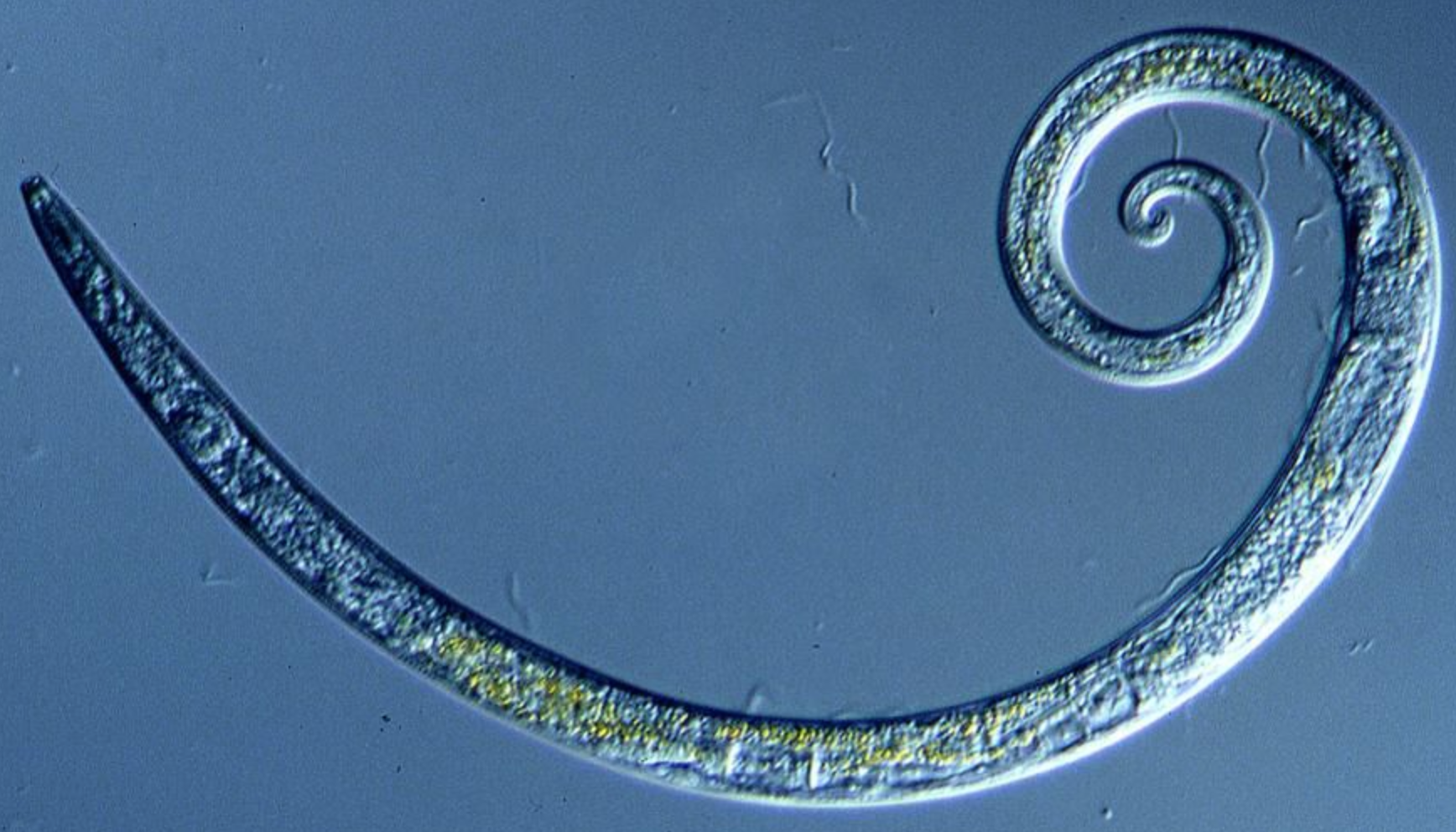
The dimensions of the nematodes vary greatly depending on the species. The smallest ones reach 80 microns in length, and the largest species, Placentonema gigantissima , living in the placenta of sperm whales, can reach up to 8.5 meters. Not that I was squeamish, but it’s even disgusting to imagine.
The nematodes that we are talking about today are extremophiles, i.e. representatives of living organisms that are able to live in very extreme conditions without any problems.

And Mono Lake is really extreme for life. Firstly, it is three times more salty than the ocean, and secondly, the pH level in it is 10 (for comparison, the pH in bleach is 12.5).
Despite such unattractive conditions, there is still life in the lake. Artemia monica crustaceans, which feed on unicellular algae and are food for more than 2 million birds of 25 species nesting in the vicinity, were considered the most massive inhabitants of Lake Mono before the discovery of nematodes. As you can see, even the most extreme places on the planet can be full of life.
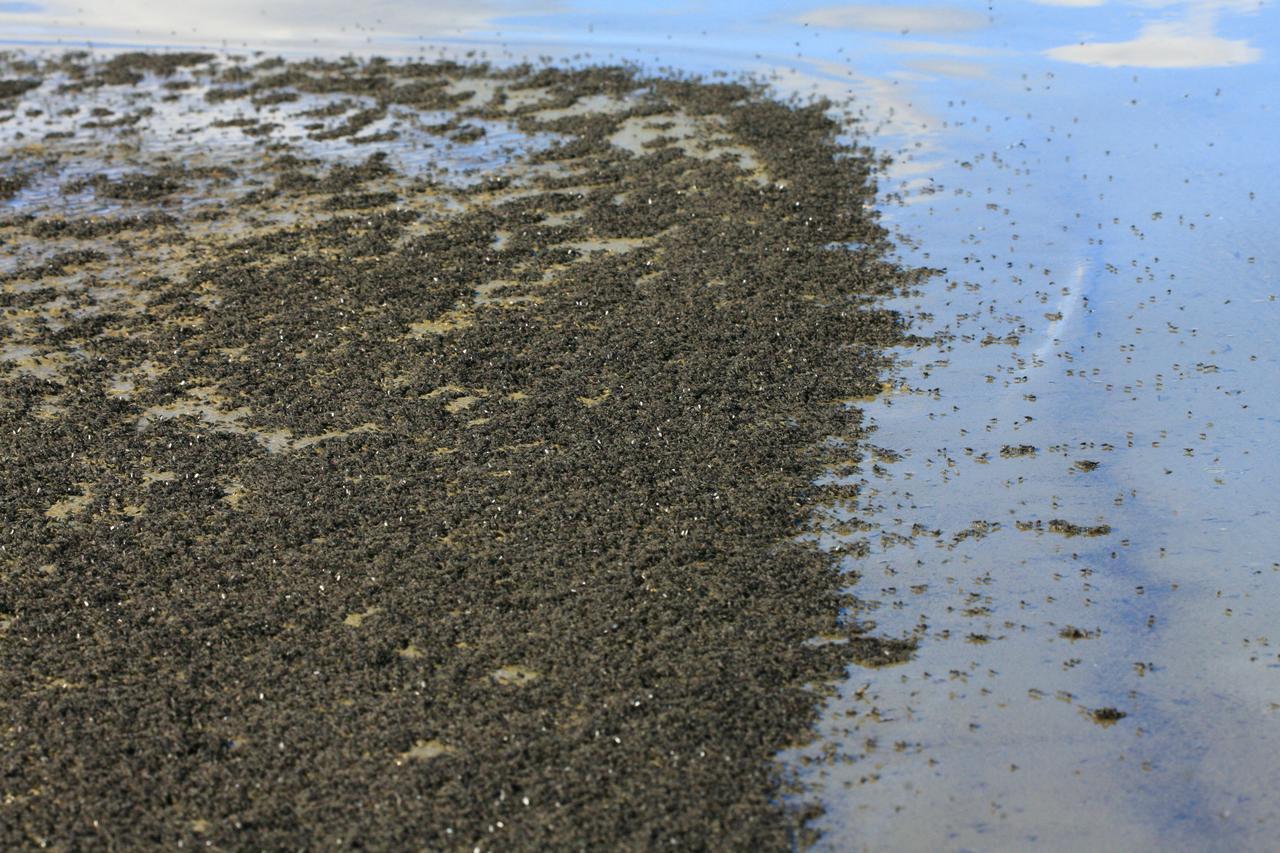
No, this is not algae, but hordes of flies on the shores of Lake Mono.
The study of nematodes living in Lake Mono allows a better understanding of the mechanisms of adaptation of animals to extreme conditions, as well as their impact on the ecosystem in this kind of environment.
Research results
It is worth noting that Mono Lake is quite large, the catchment area is 2030 km 2 , and the lake itself is about 170 km 2 , 21 km long (from east to west), and 15 km wide (from north to south). Given this, as well as a different degree of human activity around the lake, the characteristics of the water and the coast in different areas will vary to one degree or another. Therefore, to study life in the bottom sediments of Lake Mono, soil was collected from three sites:
- Plot A - Pristine Beach (beach in the northeast);
- plot B - Navy Beach (beach in the south);
- plot C - Old Marina (beach in the west).
Section A is completely inaccessible to vehicles, therefore human activity in this zone is minimal. On site B there are a lot of tuff - lime-tuff towers towering above the water due to a sharp decrease in the water level in the lake (by 15 meters by 1994), which makes this place extremely popular among tourists. Section C also has a small number of tuffs, but the coast is rocky, so there are not many people.
At each site, soil samples were taken in three zones: the dry zone, the tidal zone, and in the lake itself. Using a Berman funnel, living nematodes were isolated from soil samples, which, by the way, were not found in the water column.
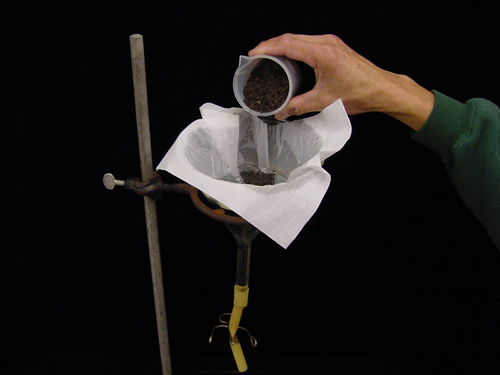
Berman's funnel
In addition to nematodes, alkaline flies and local crustaceans, i.e. just three different types of living organisms, which once again shows the severity of the environment.
In order to understand what exactly affects the growth and reproduction of nematodes in Lake Mono, scientists measured the level of mineralization and pH of all soil samples. The average pH of the samples ranged from 9 to 10 in all areas. But the degree of salinity, depending on the sampling site, varied. So, section A does not have any entry point into freshwater streams and is the most chemically extreme. But, despite this, nematodes were also found in this area (in the tidal zone). Therefore, nematodes are fully adapted to such conditions and do not live exclusively in less extreme sections of the lake.
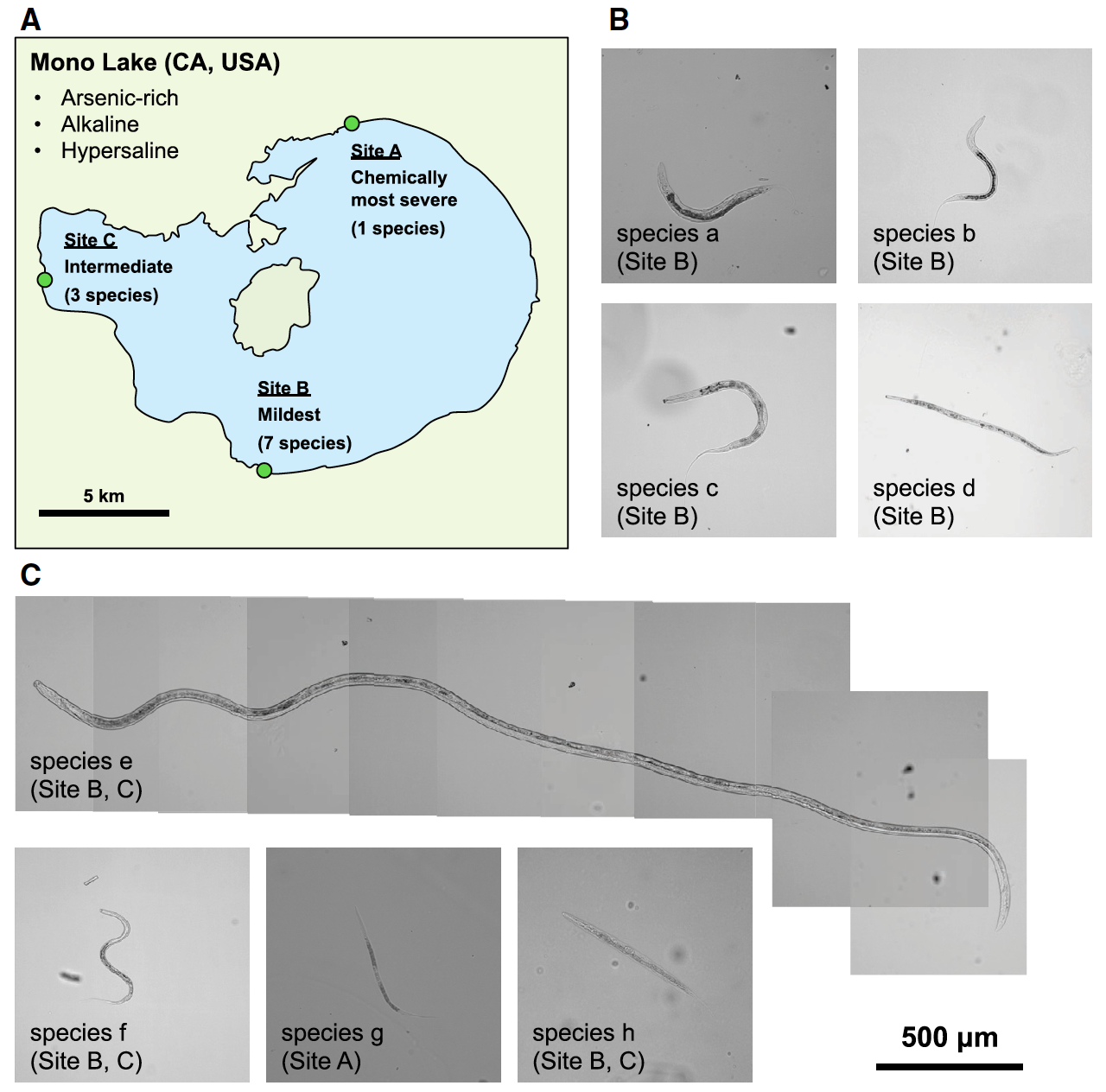
Image No. 1
Nematode DNA analysis showed the presence of 8 separate species (labeled a - h in images 1B and 1C ). One of the species was found exclusively in plot A, seven species in plot B and three species in plot C. After some time, certain species ( e and f ) were found already in other parts of the lake, which indicates their wide habitat.
Nematodes were identified by analyzing the signatures of the large subunit of the ribosomal ribonucleic acid 28 rDNA and the small subunit of the ribosomal ribonucleic acid 18 rDNA. The results showed that three of the isolated nematodes are known species, and five are previously non-sequenced species ( 2A ).

Image No. 2
The studied nematodes are distributed by phylogenesis * of nematodes ( 2B ) with the known species Mononchoides americanus (species c) and Diplogaster rivalis (d) in clade * V and Prismatolaimus dolichurus (f) in clade II. Two of the previously non-sequenced species, Auanema sp. (a) and Pellioditis sp. (b) belong to treasure V.
Phylogenesis * - the development of a biological species over time.Researchers assigned three non-sequenced species to the family, and not to the genus, since they do not have phylogenetically close species: species in Mermithidae (e, clade I) and species in Monhysteridae (g and h, between clades II and III).
Clade * is a group of organisms with a common ancestor containing all its direct descendants.
This species diversity suggests that the settlement of Lake Mono occurred through repeated colonization, the reasons for which were various, separate from each other, causes, factors and events.
Anatomically discovered species also differed from each other. Signs of three different forms of oral structures were revealed: crushers ( Auanema sp. , Pellioditis sp. , Monhysteridae ), teeth ( M. americanus and D. rivalis ) and a long esophagus with small tooth-like structures ( P. dolichurus ).
Characteristics of the animal’s oral structures make it possible to evaluate its diet and eating style. Given the data, scientists have suggested that Auanema sp. , Pellioditis sp. and Monhysteridae feed on microorganisms, M. americanus , D. rivalis , and P. dolichurus are predators. In addition, species from Mermithidae (e) belong to the family whose members are arthropod parasites. Therefore, it can be assumed that species e is a parasite of lake crustaceans and, possibly, alkaline flies.
Similar observations and discoveries allow us to conclude that it is the nematodes that are the dominant organisms in the ecosystem of Lake Mono ( 2C ), both in number and in species diversity.
The study of extremophiles and not only is often associated with their cultivation (cultivation) in laboratory conditions, which allows you to examine in detail the process of development of the organism, its behavior and responses to certain external stimuli. However, it is not always possible to cultivate in the laboratory an organism that is born, lives and dies in extremely extreme, and sometimes unpredictable, conditions. Nevertheless, scientists managed to grow in the laboratory one of the species found in Lake Mono, namely Auanema sp. ( 3A ).

Image No. 3
Two subspecies of the nematodes Auanema sp. from plot B (Navy Beach), which could be easily frozen and then thawed. Under such conditions, nematodes had a reproductive life span of 2.5–3 days at 22.5 ° C, comparable to that of C. elegans (a free-living nematode used as a model organism).
Researchers note that the genus Auanema contains five more species that were previously discovered and investigated, but none of them lived in extreme conditions.
Observations in the laboratory showed that representatives of Auanema sp. , like their relatives from the species A. rhodensis and A. freiburgensis , are divided into three sexes: hermaphrodites, males and females. At the same time, Auanema sp. possesses some unique typological, biological and phylogenetic features.
Males of this species in their structure are very different from most previously studied species, which confirms the comparison of photographs of the tail section of a male of the species Auanema sp. and C. elegans .
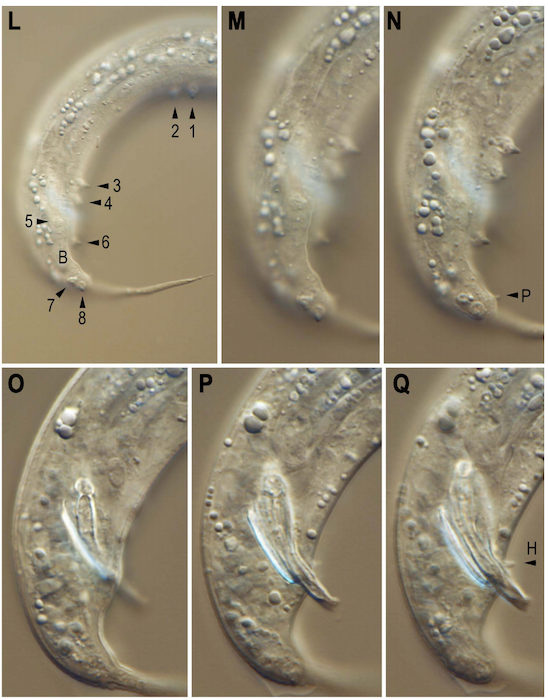
Pictures of the tail section of a male of the species Auanema sp.
L is the entire tail section, M - Q is a close-up of the back in different focal planes, the numbers indicate genital papillas, the letter B indicates the bursa * , the letter P is the phasmid, the letter H is the ventral single papilla * (hook).
Bursa * - subventral folds of the cuticle, partially or completely surrounding the tail of males.And now for comparison, look at the structure of the tail section of the male nematode of the species C. elegans , which is used in nematology as a model organism.
Phasmids * - paired lateral organs (sensory and glandular functions).
Papilla * is a cuticle outgrowth that performs a mixed receptor function.
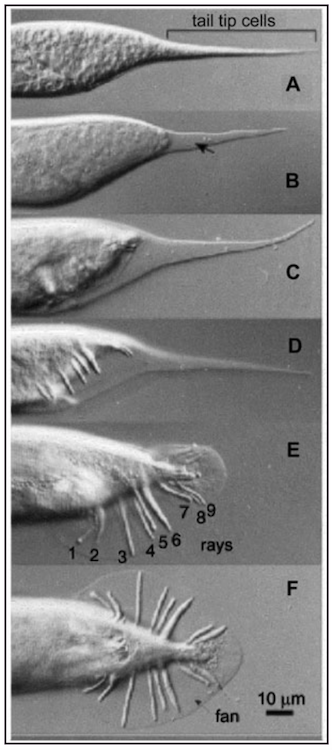
Pictures showing the development of a male C. elegans species from a larva to a mature individual.
The tail of the male is drawn in during the last 4 hours of the larval stage. Figure A shows the tail just before the start of this process. The subcutaneous cells of the tip of the tail ( B ) are the first cells that begin to stretch. The arrow in this image indicates a growing fluid-filled cavity between the surface of the future adult and the L4 cuticle. C and D show that the body begins to stretch inside the cuticle, filling it. E and F (side and top view) are pictures of a fully formed adult male nematode. The materials for this comparison are taken from here .
In males C. elegans, the tail section resembles a fan with many radial processes, but in males of the species Auanema sp. living in Mono Lake, this part of the body is distinguished by a small process in the form of a hook.
Female nematodes from the lake are also unique because they do not lay eggs, but are viviparous ( 3B shows the larva inside the female). The choice of this method of reproduction is due to harsh living conditions. Being inside the mother, the offspring receive protection from environmental influences. Therefore, there is no need to evolve in any unusual way, so that not only adults can survive in Mono Lake, but also their eggs and larvae.
Naturally, the most outstanding feature of nematodes from Lake Mono is their stability. The lake water contains a large concentration of arsenic - arsenite As (III) and arsenate As (V).
Comparative experiments were carried out with the participation of nematodes Auanema sp. (from the lake) and C. elegans (model), which, as previously established, are able to withstand a dose of arsenic 60 times the lethal for humans.
First, nematodes of both species were placed in ordinary water. Both subjects showed a high degree of survival. They were then placed in water with 1.5 mM As (III), and after 2.5 hours the survival of Auanema sp. was higher ( 4A ) than C. elegans (average survival of Auanema was 86%, and C. elegans was 35%).
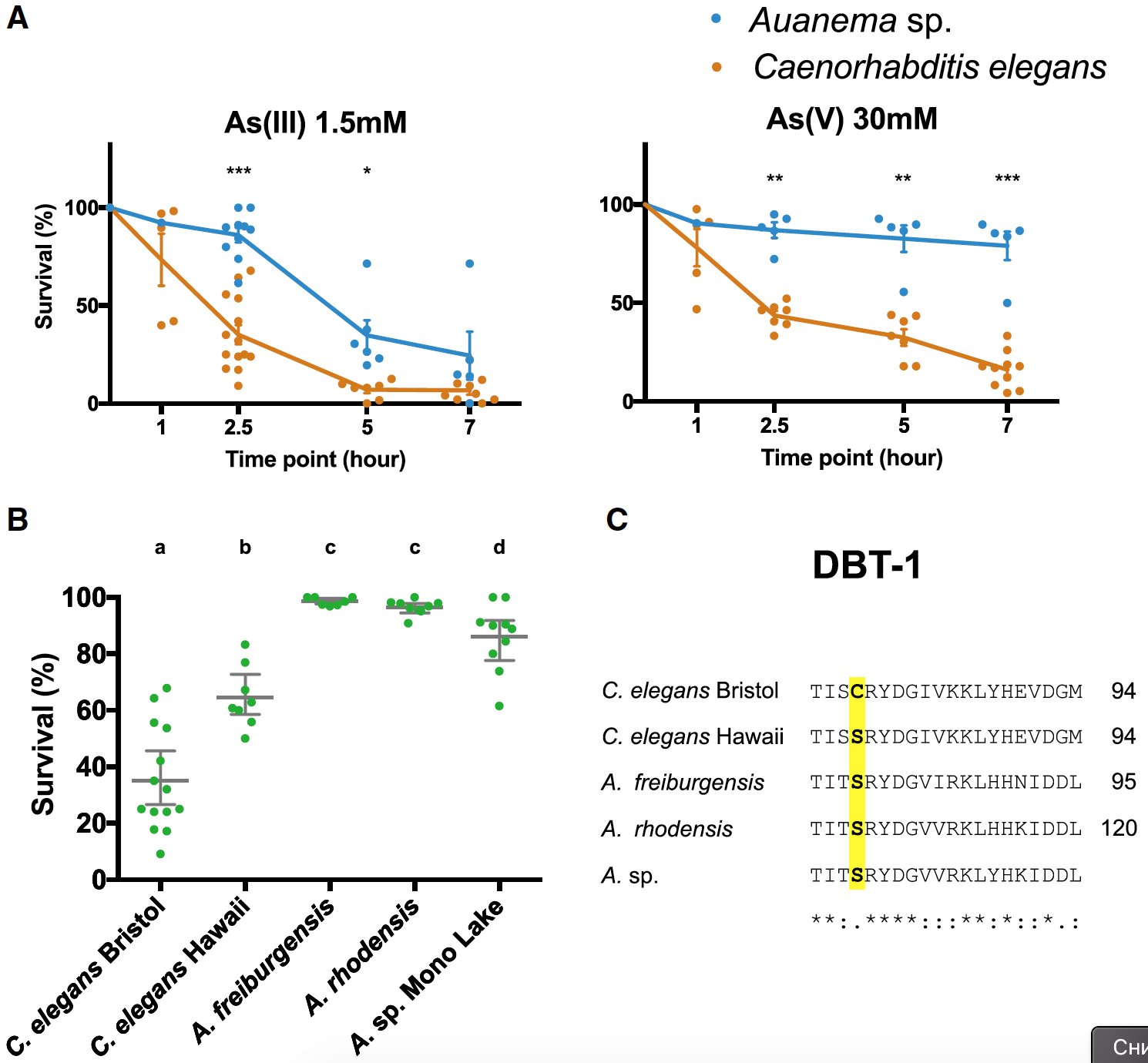
Image No. 4
After 5 hours, the trend continued: the average survival rate of Auanema sp. - 35%, and in C. elegans - 7%. At the seventh hour of the experiment, the survival of both species was extremely low: Auanema sp. - 24%, C. elegans - 7%.
One might already doubt the ability of nematodes from Lake Mono to resist arsenic, but the second stage of the experiments showed interesting results. At a concentration of As (V) of 10 mM and 30 mM Auanema sp. showed high survival even after 7 hours: Auanema sp. - 79%, and C. elegans - only 16%.
The conclusion is quite simple - Auanema sp. can withstand high concentrations of As (V) for a long time, 500 times the lethal dose for humans.
The following analysis showed even more interesting results. Scientists decided to compare arsenic resistance Auanema sp. (from the lake) and its other related species A. freiburgensis and A. rhodensis , which live in non-extreme conditions. After 2.5 hours in a bath with 1.5 mM As (III) non-extreme species showed greater survival than nematodes from Lake Mono: Auanema sp. - 86%, A. freiburgensis - 99% and A. rhodensis - 97% ( 4B ).
But how so? It turns out that resistance to arsenic in nematodes from the lake is not a unique ability? Yes and no. The fact is that this feature is a common pre-adaptive trait for the entire genus Auanema. In other words, nematodes had this ability before the colonization of the lake.
It is suggested that the strong resistance of all three Auanema species may be due to new genes or natural mutations of existing genes. One of the natural mutations that affect arsenic sensitivity in C. elegans is the missense mutation DBT-1 (C78S).
This mutation in the branched chain amino acid metabolism protein occurs in the Hawaiian subspecies C. elegans . Sequencing of dbt-1 from the three Auanema species showed the presence of a serine mutation, as in Hawaiian C. elegans ( 4C ).
For a more detailed acquaintance with the nuances of the study, I recommend that you look into the report of scientists and additional materials to it.
Epilogue
The world is full of life-threatening places where, by the logic of things, life should not exist. However, the same could be said about the planet itself at the beginning of time. Life can exist in any conditions, only time is needed in order to adapt.
Of course, the nematodes from Lake Mono already had a certain degree of adaptability to the harsh environment, but in the process of colonization the lakes acquired several new traits that only increased their endurance and, as a result, the chances of a successful existence where others die.
But even the most enduring creatures on our planet will sooner or later face an inevitable problem - with us. The development of mankind has led to the extinction of many species, even extremophiles. This does not mean that a person is a real evil, it only says that we, as a species, need to understand the relationship of everything that surrounds us. For example, Mono Lake is a dangerous habitat for many, however, it is a nesting site for about 2 million birds of 25 different species. These birds feed on alkaline flies and lake crustaceans, which feed on unicellular algae. What happens if these algae cease to exist? The answer, sadly, is very obvious. The progress machine cannot be stopped, but it can be controlled much more accurately and responsibly with an eye on those who are not sitting in it.
Friday off-top:
A small video about extremophiles discovered at a depth of 3600 m in South Africa.
Thank you for your attention, remain curious, respect the nature and have a great weekend everyone, guys! :)
A small video about extremophiles discovered at a depth of 3600 m in South Africa.
Thank you for your attention, remain curious, respect the nature and have a great weekend everyone, guys! :)
Thank you for staying with us. Do you like our articles? Want to see more interesting materials? Support us by placing an order or recommending it to your friends, a 30% discount for Habr users on a unique analogue of entry-level servers that was invented by us for you: The whole truth about VPS (KVM) E5-2650 v4 (6 Cores) 10GB DDR4 240GB SSD 1Gbps from $ 20 or how to divide the server? (options are available with RAID1 and RAID10, up to 24 cores and up to 40GB DDR4).
Dell R730xd 2 times cheaper? Only we have 2 x Intel TetraDeca-Core Xeon 2x E5-2697v3 2.6GHz 14C 64GB DDR4 4x960GB SSD 1Gbps 100 TV from $ 199 in the Netherlands! Dell R420 - 2x E5-2430 2.2Ghz 6C 128GB DDR3 2x960GB SSD 1Gbps 100TB - from $ 99! Read about How to Build Infrastructure Bldg. class c using Dell R730xd E5-2650 v4 servers costing 9,000 euros for a penny?
All Articles